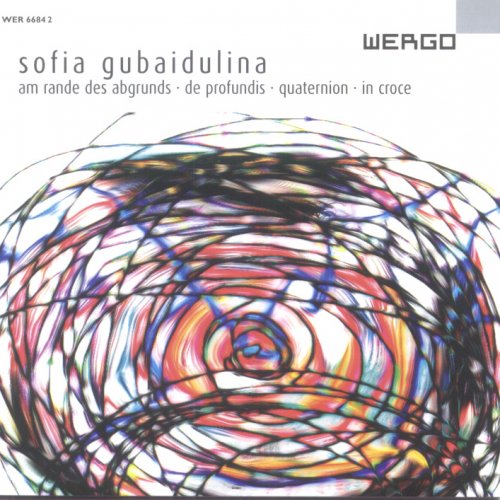
Sofia Gubaidulina - Am Rande des Abgrunds, De profundis, Quaternion, In croce (2006)
BAND/ARTIST: Sofia Gubaidulina, Julius Berger, Stefan Hussong
- Title: Am Rande des Abgrunds, De profundis, Quaternion, In croce
- Year Of Release: 2006
- Label: Wergo
- Genre: Classical
- Quality: FLAC (image+.cue,scans)
- Total Time: 71:15
- Total Size: 299 Mb
- WebSite: Album Preview
Tracklist:
1. Am Rande des Abgrunds (for 7 violoncelli and 2 aquaphons) (2002) (15:38)
2. De profundis (for bayan/accordion solo) (13:52)
3. Quaternion (for 4 violoncelli) (27:09)
4. In croce (for violoncello and bayan/accordeon) (14:19)
Performers:
Julius Berger: violoncello solo
Stefan Hussong: accordion
Sofia Gubaidulina, Viktor Suslin: aquaphones
Niklas Eppinger, Aleksandra Ohar, Diego Garcia, Yoonha Choi, Yoon-Jung Hwang, Tai-Yang Zhang: violoncelli
1. Am Rande des Abgrunds (for 7 violoncelli and 2 aquaphons) (2002) (15:38)
2. De profundis (for bayan/accordion solo) (13:52)
3. Quaternion (for 4 violoncelli) (27:09)
4. In croce (for violoncello and bayan/accordeon) (14:19)
Performers:
Julius Berger: violoncello solo
Stefan Hussong: accordion
Sofia Gubaidulina, Viktor Suslin: aquaphones
Niklas Eppinger, Aleksandra Ohar, Diego Garcia, Yoonha Choi, Yoon-Jung Hwang, Tai-Yang Zhang: violoncelli
This CD brings together four chamber works by Sofia Gubaidulina dating from 1978 to 2002. Part of the reason Gubaidulina's works are so aurally appealing is that, in spite of being thoroughly "modern," they are innovative not so much in their pitch organization, the hallmark of modernism in twentieth century music, but in their innovative timbral qualities and the individuality of their approach to structure. Another element in their appeal is the sensitivity and musicality with which she assembles her colorful structures -- her gestures always seem precisely placed, based on her mysterious but convincing musical logic. An analyst would be hard-pressed to explain just why her music works so well, but the fact that it does work is inarguable.
Am Rande des Abgrunds (On the Edge of the Abyss), scored for the eccentric combination of seven celli and two waterphones, is notable for its disarming simplicity. Its prevailing tone of spaciousness and naïve calm, punctuated by percussive outbursts, gives way to a more tumultuous section that is interrupted by moments of great harmonic sweetness and the otherworldly glissandi of waterphones. Gubaidulina uses the accordion, played here by virtuoso Stefan Hussong, to make her De Profundis a great heaving prayer for deliverance from the depths. Her largely introspective Quaternion, a quartet for pairs of cellos tuned a quarter tone apart lasting nearly half an hour, seems less immediately engaging than the other works on the CD, perhaps because even though the composer draws a wide range of colors and sounds from the celli, the textural and coloristic variety of the homogenous ensemble is more muted than that of the works that surround it, and its extended unfolding requires more patience from the listener. Quaternion would probably have been better placed on the first track, where its considerable strengths could have made an impression before being upstaged by the more exotic sonic worlds of the other works.
The performers give exquisitely detailed attention to the nuances of the music and play with complete conviction and technical finesse. The clear and vibrant sound quality of Wergo's recording is exemplary.
Am Rande des Abgrunds (On the Edge of the Abyss), scored for the eccentric combination of seven celli and two waterphones, is notable for its disarming simplicity. Its prevailing tone of spaciousness and naïve calm, punctuated by percussive outbursts, gives way to a more tumultuous section that is interrupted by moments of great harmonic sweetness and the otherworldly glissandi of waterphones. Gubaidulina uses the accordion, played here by virtuoso Stefan Hussong, to make her De Profundis a great heaving prayer for deliverance from the depths. Her largely introspective Quaternion, a quartet for pairs of cellos tuned a quarter tone apart lasting nearly half an hour, seems less immediately engaging than the other works on the CD, perhaps because even though the composer draws a wide range of colors and sounds from the celli, the textural and coloristic variety of the homogenous ensemble is more muted than that of the works that surround it, and its extended unfolding requires more patience from the listener. Quaternion would probably have been better placed on the first track, where its considerable strengths could have made an impression before being upstaged by the more exotic sonic worlds of the other works.
The performers give exquisitely detailed attention to the nuances of the music and play with complete conviction and technical finesse. The clear and vibrant sound quality of Wergo's recording is exemplary.
As a ISRA.CLOUD's PREMIUM member you will have the following benefits:
- Unlimited high speed downloads
- Download directly without waiting time
- Unlimited parallel downloads
- Support for download accelerators
- No advertising
- Resume broken downloads


